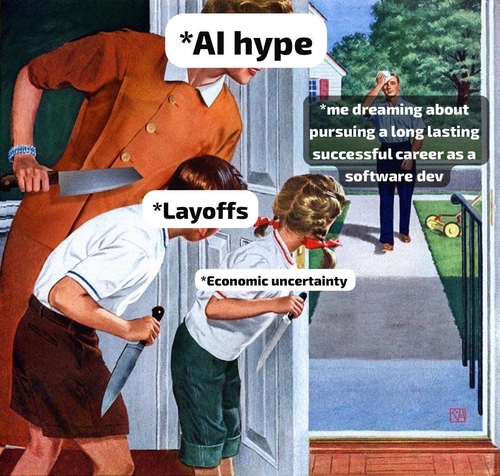🔗 View in your browser. | ✍️ Publish on FAUN.dev | 🦄 Become a sponsor
Kaptain
#Kubernetes #Docker #DistributedSystems
📝 The Opening Call
Imagine Docker Compose crossing paths with AI agents, while Pinterest leaves Hadoop in the dust with a turbocharged Kubernetes setup. Meanwhile, switching to Claude Code inside Docker containers could be the safety net your AI project never knew it needed and Helm’s a seamless dance partner for advanced deployments.
🤖 Automatic Helm Deployments with Ansible
🔄 Backup for GKE Supports Cross-Project Restore
🚀 Docker Brings Compose to the Agent Era
🐙 Docker Desktop 4.43: Expanded Model Runner
🔌 How I Finally Understood Virtual Machines vs Containers
🔧 Kubernetes List API: Performance Boosts
🌐 Next Gen Data Processing at Pinterest With Moka
🛠️ Use K8sGPT and Amazon Bedrock for Kubernetes
🗜️ Which Kubernetes is the Smallest?
🔍 Managing Kubernetes Port-Forwards in One Place
Keep forging ahead—innovation is your playground.
Have a great week!
FAUN Team
🤖 Automatic Helm Deployments with Ansible
🔄 Backup for GKE Supports Cross-Project Restore
🚀 Docker Brings Compose to the Agent Era
🐙 Docker Desktop 4.43: Expanded Model Runner
🔌 How I Finally Understood Virtual Machines vs Containers
🔧 Kubernetes List API: Performance Boosts
🌐 Next Gen Data Processing at Pinterest With Moka
🛠️ Use K8sGPT and Amazon Bedrock for Kubernetes
🗜️ Which Kubernetes is the Smallest?
🔍 Managing Kubernetes Port-Forwards in One Place
Keep forging ahead—innovation is your playground.
Have a great week!
FAUN Team
⭐ Patrons
info.perfectscale.io
Running Kubernetes efficiently is already complex. Add LLM workloads, and suddenly you're dealing with expensive GPU nodes that can't afford to sit idle.
Join Arthur Berezin (VP Product at PerfectScale by DoiT) and Anton Weiss (Chief Cluster Whisperer) as they share a clear, proven approach to optimizing Kubernetes costs without compromising reliability.
You'll learn:
→ How to manage CPU, memory, and GPU resources per workload.
→ How to align these with autoscaling for maximum efficiency.
✅ Clear code examples. ✅ Real use cases. ✅ No fluff.
Only 50 seats available. Register now !
Join Arthur Berezin (VP Product at PerfectScale by DoiT) and Anton Weiss (Chief Cluster Whisperer) as they share a clear, proven approach to optimizing Kubernetes costs without compromising reliability.
You'll learn:
→ How to manage CPU, memory, and GPU resources per workload.
→ How to align these with autoscaling for maximum efficiency.
✅ Clear code examples. ✅ Real use cases. ✅ No fluff.
Only 50 seats available. Register now !
ℹ️ News, Updates & Announcements
venturebeat.com
Solo.io, a Cambridge-based cloud-native networking company, was named “Most Likely to Succeed” at the VB Transform Innovation Showcase in San Francisco on June 25.Founded in 2017, Solo.io offers tools to connect, secure, and monitor modern applications — especially those built on Kubernetes and microservices. The company raised \$135M in Series C funding in 2021 and holds a \$1B valuation
helpnetsecurity.com
AI's Wobbly Ride with Developers—A staggering 76% of IT/SaaS folks embrace it, compared to a measly 22% across the board. Meanwhile, ChatGPT shoots up to an 82% adoption rate, blazing past others. The days of hunching over desktops are fading; 64% of devs now thrive in the cloud or remote setups. Security's finally getting its due, though planning and coordination still trip things up, like a pebble in your shoe. Python reigns supreme with 64% of users, MongoDB leads the database pack at 21%, and containers have conquered with a whopping 92% usage in IT.
aws.amazon.com
K8sGPT teams up with Amazon Bedrock to turbocharge Kubernetes operations. Think AI insights, faster debugging, and self-healing magic worthy of a veteran SRE. K8sGPT harnesses AI models like Claude and OpenAI in two ways: The trusty CLI for nimble maneuvers and Operator for relentless, watchful monitoring inside Kubernetes clusters.
docker.com
Docker Compose now makes building and cranking up intelligent agents a breeze, effortlessly meshing with smart frameworks like Vercel AI SDK and Google's ADK. Unburden your machine by tossing compute-heavy tasks to the cloud with Docker Offload for that sweet GPU boost. Keep local resources untangled and your development journey smooth, from laptop to cloud, like it should be.
kftray.app
Meet the Rust-infused lifesaver sweeping away Kubernetes port-forwarding mayhem. It tames connections by routing everything through one neat hub. TCP and UDP? Handled effortlessly. Picture a pod bridging UDP traffic over TCP with precision, serving up a swanky GUI or a no-nonsense terminal view. Add a dash of Git magic for slick config syncing, and voilà—chaos controlled.
cloud.google.com
Backup for GKE just got a power-up. Now, you can zip data from one Google Cloud project and unpack it in another. This shake-up makes disaster recovery smoother, teamwork easier, and security tighter by keeping backups out of the wrong hands. All the control, none of the headache. No scripts needed.
docker.com
Docker Desktop 4.43 cranks up AI integration with the Model Runner. OpenAI APIs? Now they're putty in your hands. Fine-tune model runtime with ease. Enter Docker’s Gordon—the multitasker extraordinaire who juggles threads like a caffeinated circus performer. Enjoy speeds and accuracy that make old versions look like snails. To top it off, the Compose Bridge turns your Compose files into Kubernetes configs faster than you can say "YAML." One command. That's it.
🐾 From FAUNers
faun.pub
Wrangle ClickHouse backups in Kubernetes like you own the place. Get cozy with a sidecar tool and stash everything in GCS storage. Automate your glory with CronJobs and Jobs. Think midnight backups—handled without a sweat. Saves the 2 AM freakouts.
faun.pub
Bottlerocket, Amazon's container host OS, scraps SSH like yesterday's software and opts for admin containers via SSM. It aligns beautifully with EKS security. Oh, and it teams up with Karpenter to launch nodes on the fly, keeping things smooth and snappy.
faun.pub
C.R.A.F.T turns AI into your DevOps sidekick. It dishes out roles, actions, formats, and tones with swagger, wiping out any robotic boredom. Think custom prompts that crack the code of senior insights; it's like upgrading AI-pattern mimicry into a tête-à-tête with a tech sage.
🔗 Stories, Tutorials & Articles
medium.com
VMs: Think of it as leasing that high-rise corner office—yours to deck out, private but a bit of a memory hog. Containers: More like shacking up with roommates—compact, super speedy, and easy to share the load.
xda-developers.com
Gluetun provides a powerful and lightweight solution for routing outbound traffic from Docker containers through a secure VPN tunnel, offering improved privacy, isolation, and control for select applications in a home lab or development environment.
faun.pub
Ansible wields its off-the-shelf modules like a charm bracelet, linking arms with Docker and Kubernetes. It turns the rut of Helm setup into a dance, orchestrating across machines like a seasoned conductor. Declare your Kubernetes resources with the flair of a playwright using Helm charts. Then, invite automation to join you for deployments that are as smooth as a Rube Goldberg machine when every piece clicks.
timsh.org
Using Claude Code in Docker through VSCode's Dev Containers isn't just about tech—it’s about keeping your AI in a safe little box where it can't wreak havoc on your setup. Picture this: no panic over unexpected system tantrums. Plus, say goodbye to absurd rate limits and hefty bills. A bonus, particularly when side-by-side with the spendy likes of Cursor Pro.
siderolabs.com
Talos Linux slashes maintenance time by two-thirds. It outsmarts the competition with 47% less disk space and 49% less disk I/O. Say goodbye to OS bloat. Revel in simplicity.
daryllswer.com
Docker's playing it cool with native routed IPv6. No more clumsy hacks like NAT66. It’s Layer 3 purity—straight-up packet forwarding. Complexity? Toss it. Say hello to sleek routing. Bring your A-game with BGP for routing and tailor-made firewall rules for smooth, peer-to-peer traffic handling.
medium.com
Pinterest kicked its creaky Hadoop system to the curb and embraced Moka, a shiny Kubernetes + *AWS EKS platform, to crank up scalability and security.* Graviton ARM EC2 instances, Spark Operator, and Apache YuniKorn unleashed a performance beast and sliced costs. They wrestled with memory monsters and JDK upgrades, snagging a 5% performance upgrade. Moka now commands 70% of Pinterest's Spark workloads. By year's end, Hadoop will be six feet under.
ahmet.im
Kubernetes has a meltdown during list calls in massive clusters. Imagine the apiservers screaming from out-of-memory pains when dealing with over 100k pods. Enter v1.31+, lending a hand with an in-memory watch cache to lighten the load. But let's be real—v1.34 is the hero we need, finally syncing pagination with the cache. Say goodbye to data overflows.
💬 Discussions, Q&A & Forums
⚙️ Tools, Apps & Software
github.com
A Proof of Concept (PoC) for building and running Pro*COBOL programs in containers for deployment on Kubernetes
github.com
Wakemae is a lightweight DNS server for Docker containers. Simply add labels to your containers to automatically access them by domain name. This project is similar dnsdock.
github.com
Private k3s Kubernetes Terraform installer for Hetzner Cloud
🤔 Did you know?
Did you know that GitHub doesn’t use any secret VM booting tricks, but instead dramatically cuts CI/CD startup times by maintaining warm runner pools? These pools hold pre-configured VMs or containers ready with common dependencies, so jobs can begin in 5–10 seconds instead of minutes. As demand rises, additional runners are spun up, balancing developer speed, resource flexibility, and cost—all while avoiding cold-start delays.
🤖 Once, SenseiOne Said
"In the labyrinth of modern infrastructure, automation is both the key and the minotaur."
— Sensei
— Sensei
👤 This Week's Human
Meet Bogdan Marian , Technical Director at Riverbed Technology. With over 20 years in software development across diverse sectors, Bogdan leads cutting-edge projects, such as an observability & monitoring SaaS product using micro-services on Azure. His commitment to fostering healthy engineering practices and his contributions to open source software since 2008 underscore his deep passion for technology. Known for his advocacy of continuous integration and delivery, Bogdan's dedication extends beyond code as a public speaker sharing insights at Romanian IT conferences.
😂 Meme of the week


